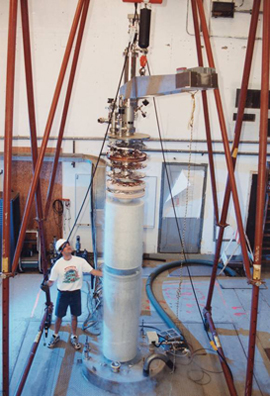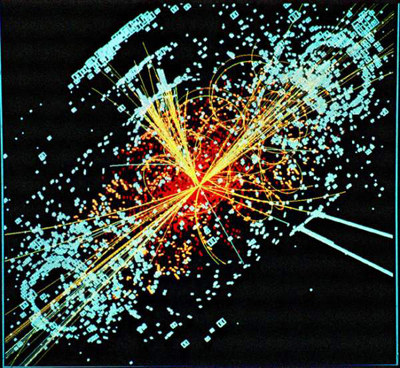Despite the compelling evidence for dark matter, the issue of whether dark matter exists or gravity needs to be modified will likely not be resolved until dark matter particles are detected, or ruled out by lack of detection.
Two types of experimental searches for dark matter candidates are being pursued by a number of investigators. These involve the direct detection of dark matter particles by some type of detector, and the detection of X-rays or gamma-rays from the decay or annihilation of dark matter particles.
If WIMPs (Weakly Interacting Massive Particles) are the dark matter, then we must be swimming in a sea of dark matter and a billion or more of them would be passing through our bodies every second. The problem for their detection is the "weakly interacting" nature of WIMPs. Fortunately for us, almost all of them would pass through our bodies and through the entire Earth.
However, it is possible that once in a great while a WIMP could collide with an atom and knock its nucleus askew, creating a minuscule vibration in a supercooled crystal detector. So far, the most sensitive of such experiments, the Cryogenic Dark Matter Search located half a mile underground in an old iron-ore mine in Minnesota, has failed to detect any WIMPs. More sensitive experiments are planned.
Work being done at the Cryogenic Dark Matter Search, an attempt
to detect Weakly Interacting Matter Particles, or WIMPs.
Axions may also be detected directly, though using very different techniques. These hypothetical particles are predicted to interact with a strong magnetic field, to produce radio waves. Experiments such as the Axion Dark Matter Experiment have so far yielded negative results. Experiments using different techniques are planned for the near future.

The Large Hadron Collider (LHC) is the world's
largest and highest- energy particle accelerator
and is scheduled to become operational in 2009.
Another approach is to detect dark matter indirectly by observing a unique signature from their decay. Most theories for WIMPs predict that when they collide, they annihilate and produce a shower of high-energy particles and radiation. One of the most important programs of NASA's Fermi Gamma-ray Telescope will be to search for gamma rays from the annihilation of WIMPs, or from the interaction of axions with strong magnetic fields in the nuclei of galaxies. It is also possible that the decay of sterile neutrinos into X-rays could be detected by Chandra, XMM, or a future, larger X-ray telescope.
Rather than taking a passive approach of observing dark matter directly in the lab, or indirectly through astronomical observations, some physicists propose making the stuff. Since the dark matter particles were presumably created in the first few nanoseconds or so of the Big Bang when temperatures were a quadrillion degrees, a particle accelerator that reproduces these conditions might create dark matter.
Extensive searches have been conducted for new particles of many kinds at and the Tevatron collider at Fermilab, so far without detection. Physicists are eagerly looking forward to the start of operations in late 2008 of the Large Hadron Collider (LHC) at CERN in Switzerland. The LHC will be the world's most powerful particle accelerator, smashing protons together at energies of 10 trillion electron volts, high enough to produce many predicted versions of dark matter.

This graphic represents a simulated event at the LHC depicting the
decay of a Higgs particle following a collision of two protons.
The bottom line: one way or another, many physicists and astronomers are optimistic that hard evidence for dark matter particles will be found in the next few years. If not, they will be faced with an even deeper mystery than they now confront.





